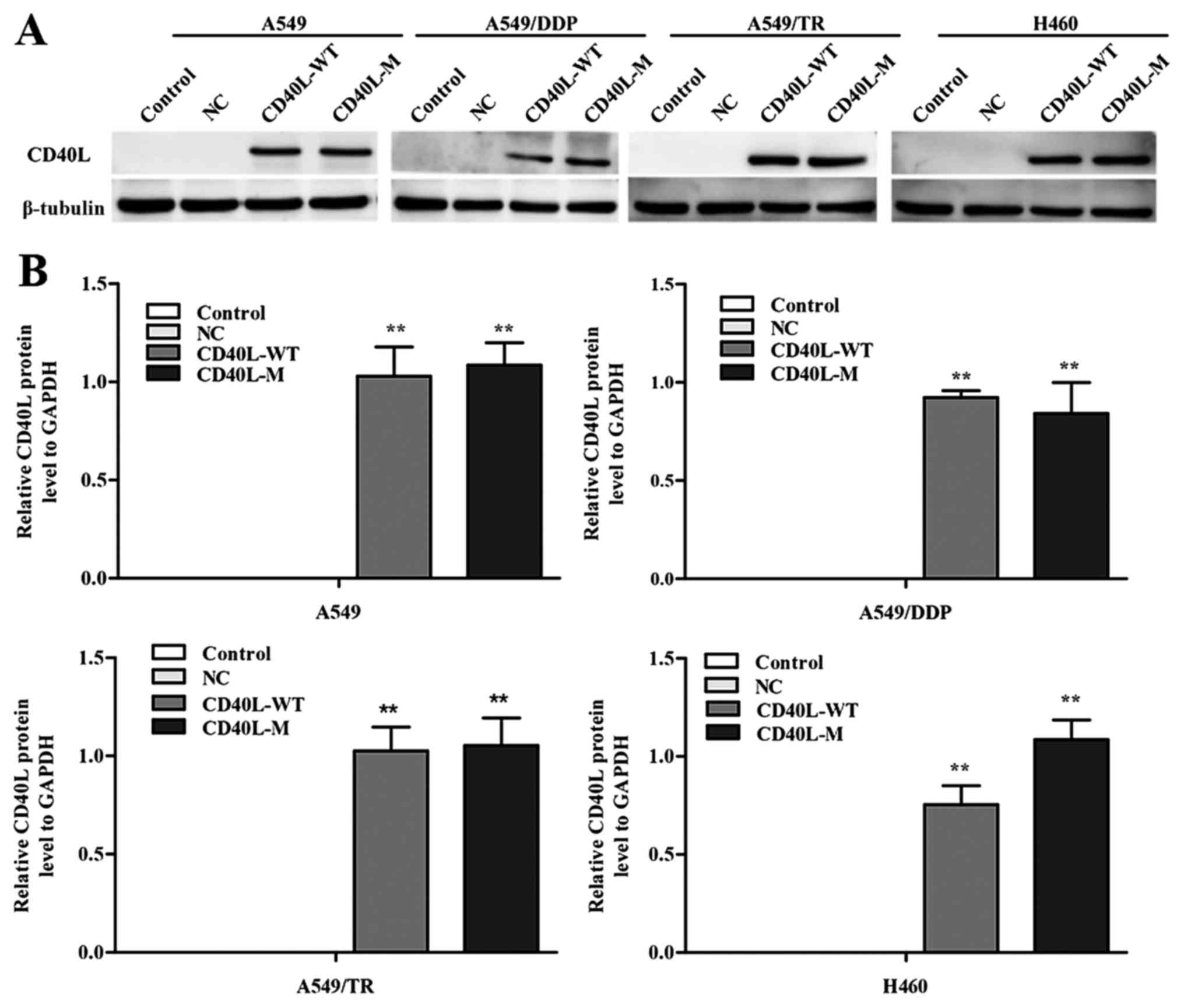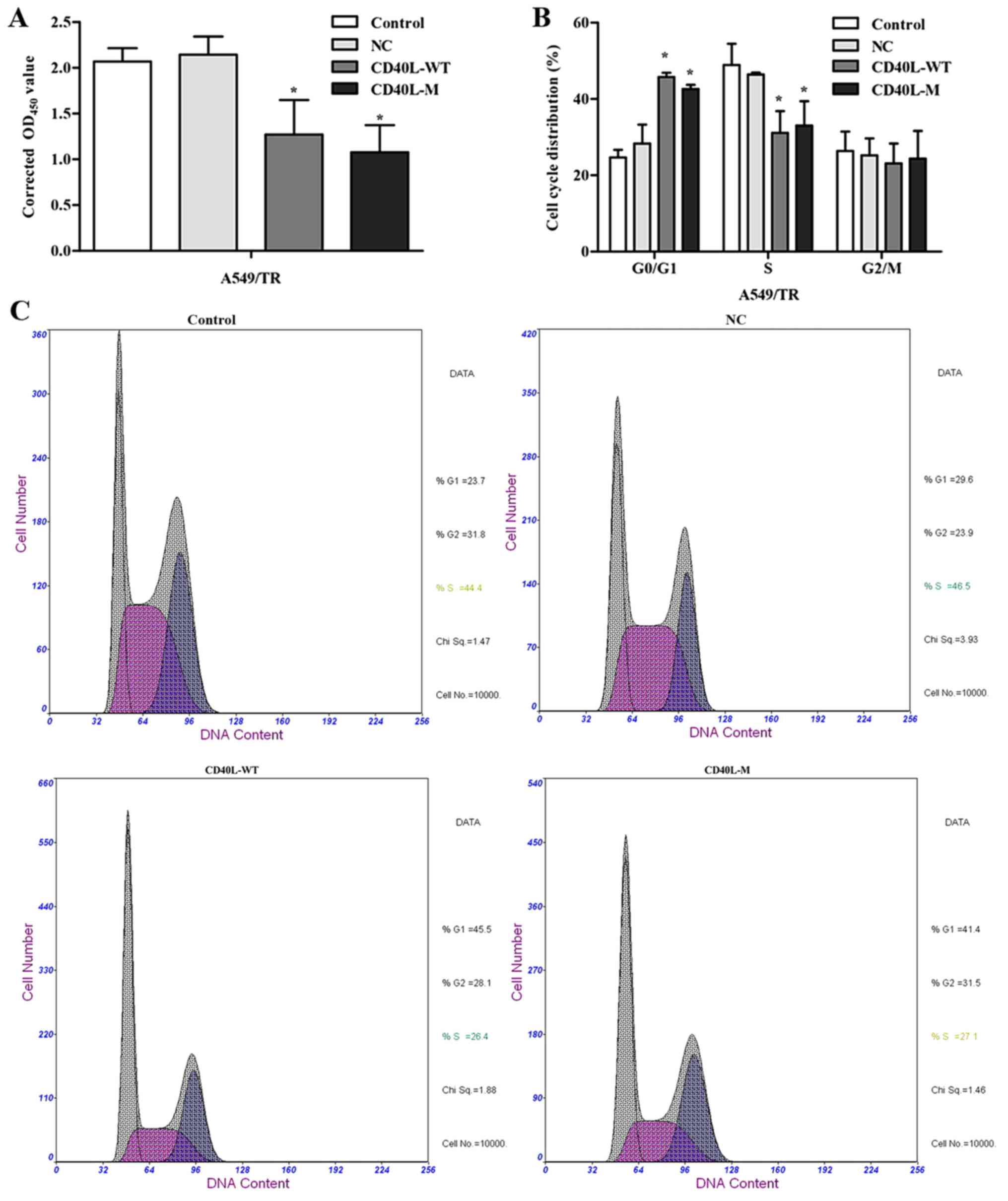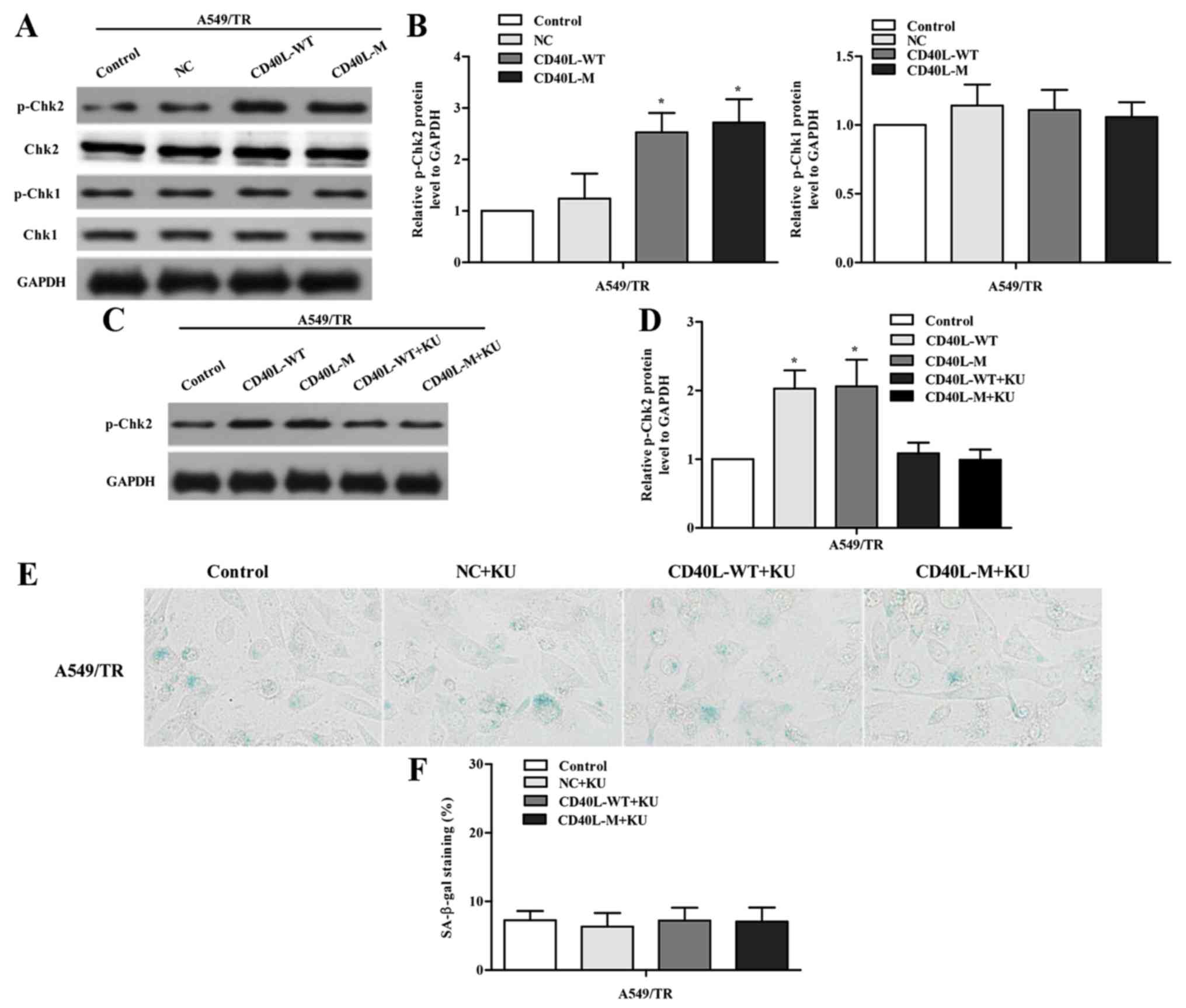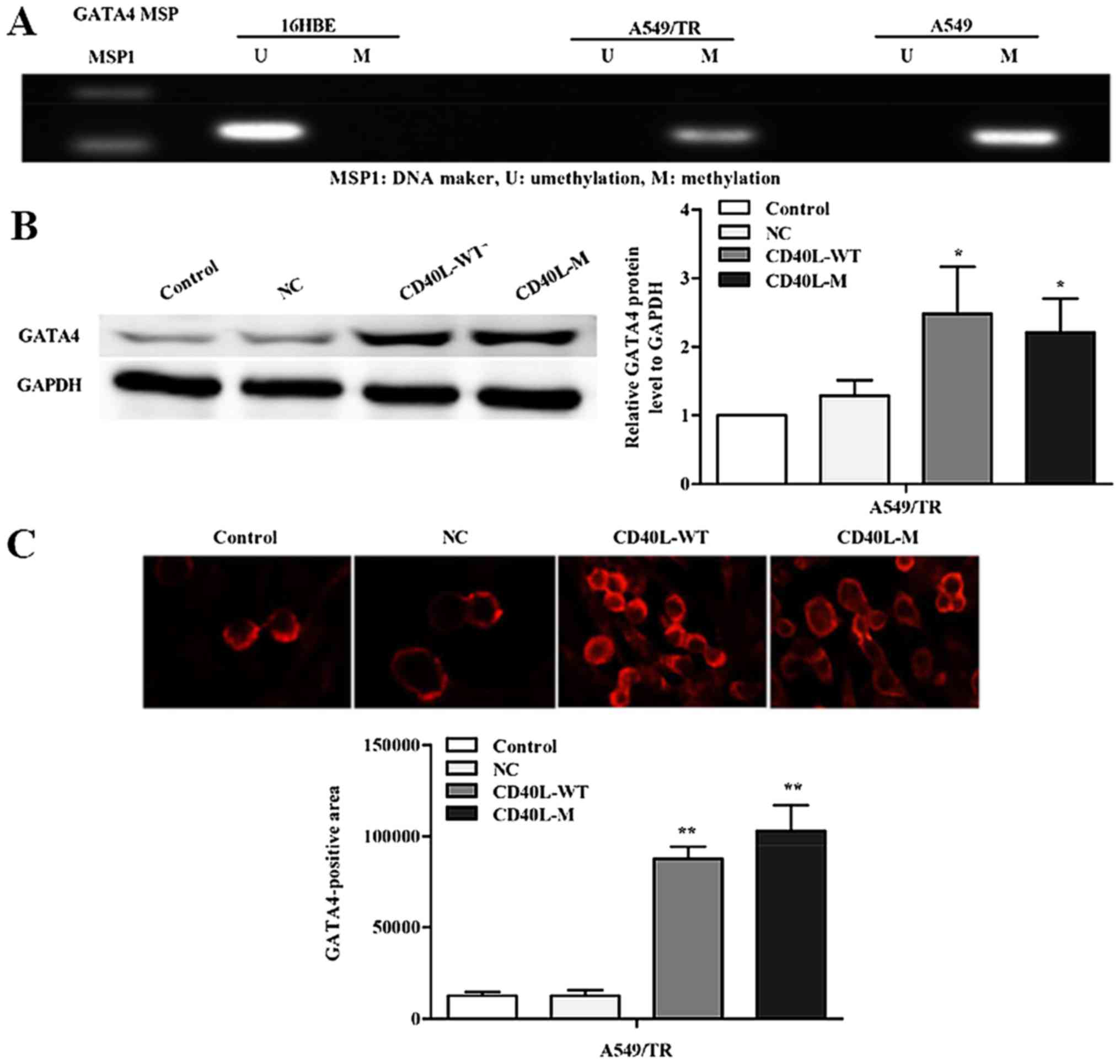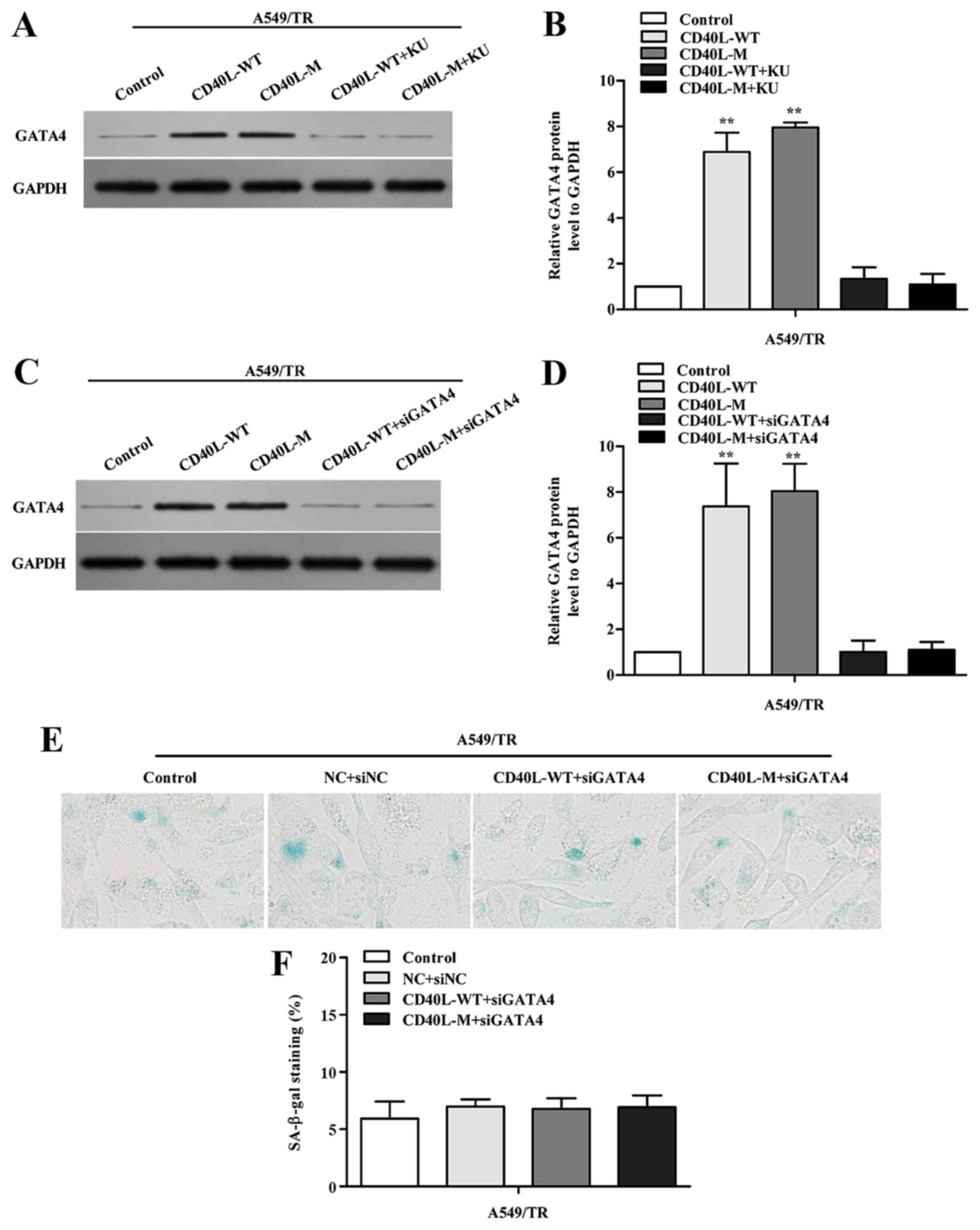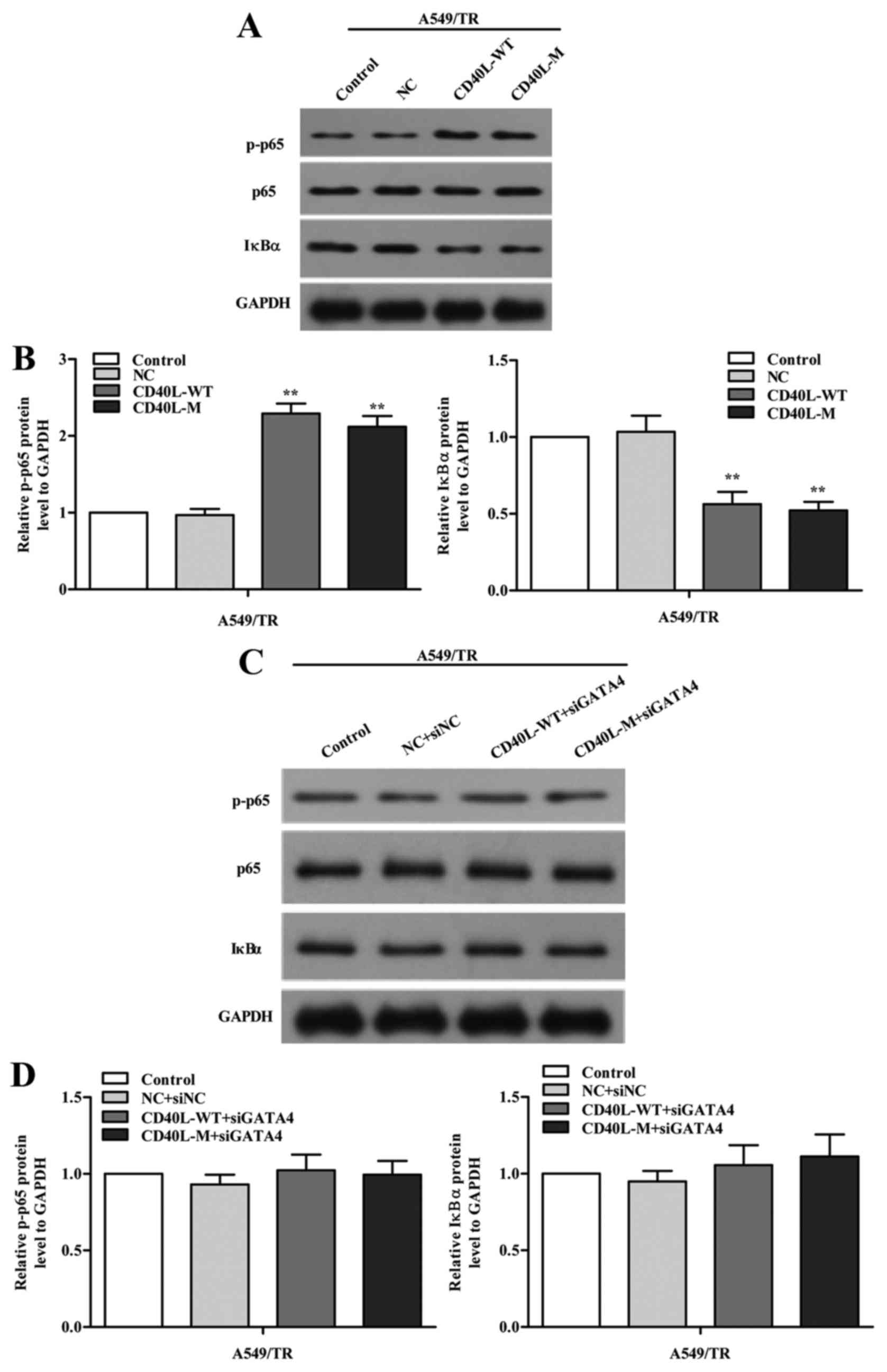|
1
|
Cao X, Lai S, Hu F, Li G, Wang G, Luo X,
Fu X and Hu J: miR-19a contributes to gefitinib resistance and
epithelial mesenchymal transition in non-small cell lung cancer
cells by targeting c-Met. Sci Rep. 7:29392017. View Article : Google Scholar : PubMed/NCBI
|
|
2
|
Hirsch FR, Scagliotti GV, Mulshine JL,
Kwon R, Curran WJ Jr, Wu YL and Paz-Ares L: Lung cancer: Current
therapies and new targeted treatments. Lancet. 389:299–311. 2017.
View Article : Google Scholar : PubMed/NCBI
|
|
3
|
Wang W, Chen P, Tang M, Li J, Pei Y, Cai
S, Zhou X and Chen S: Tumstatin 185–191 increases the sensitivity
of non-small cell lung carcinoma cells to cisplatin by blocking
proliferation, promoting apoptosis and inhibiting Akt activation.
Am J Transl Res. 7:1332–1344. 2015.PubMed/NCBI
|
|
4
|
Ge H, Ni S, Wang X, Xu N, Liu Y, Wang X,
Wang L, Song D, Song Y and Bai C: Dexamethasone reduces sensitivity
to cisplatin by blunting p53-dependent cellular senescence in
non-small cell lung cancer. PLoS One. 7:e518212012. View Article : Google Scholar : PubMed/NCBI
|
|
5
|
López-Otín C, Blasco MA, Partridge L,
Serrano M and Kroemer G: The hallmarks of aging. Cell.
153:1194–1217. 2013. View Article : Google Scholar : PubMed/NCBI
|
|
6
|
Childs BG, Durik M, Baker DJ and van
Deursen JM: Cellular senescence in aging and age-related disease:
From mechanisms to therapy. Nat Med. 21:1424–1435. 2015. View Article : Google Scholar : PubMed/NCBI
|
|
7
|
Kuilman T, Michaloglou C, Mooi WJ and
Peeper DS: The essence of senescence. Genes Dev. 24:2463–2479.
2010. View Article : Google Scholar : PubMed/NCBI
|
|
8
|
Schönbeck U, Mach F and Libby P: CD154
(CD40 ligand). Int J Biochem Cell Biol. 32:687–693. 2000.
View Article : Google Scholar : PubMed/NCBI
|
|
9
|
Gomes EM, Rodrigues MS, Phadke AP, Butcher
LD, Starling C, Chen S, Chang D, Hernandez-Alcoceba R, Newman JT,
Stone MJ and Tong AW: Antitumor activity of an oncolytic
adenoviral-CD40 ligand (CD154) transgene construct in human breast
cancer cells. Clin Cancer Res. 15:1317–1325. 2009. View Article : Google Scholar : PubMed/NCBI
|
|
10
|
Vardouli L, Lindqvist C, Vlahou K, Loskog
AS and Eliopoulos AG: Adenovirus delivery of human CD40 ligand gene
confers direct therapeutic effects on carcinomas. Cancer Gene Ther.
16:848–860. 2009. View Article : Google Scholar : PubMed/NCBI
|
|
11
|
Masuda H, Mori M, Uchida T, Uzawa A,
Ohtani R and Kuwabara S: Soluble CD40 ligand contributes to
blood-brain barrier breakdown and central nervous system
inflammation in multiple sclerosis and neuromyelitis optica
spectrum disorder. J Neuroimmunol. 305:102–107. 2017. View Article : Google Scholar : PubMed/NCBI
|
|
12
|
Xu W, Li Y, Wang X, Wang C, Zhao W and Wu
J: Anti-tumor activity of gene transfer of the membrane-stable
CD40L mutant into lung cancer cells. Int J Oncol. 37:935–941.
2010.PubMed/NCBI
|
|
13
|
Agnihotri S, Wolf A, Munoz DM, Smith CJ,
Gajadhar A, Restrepo A, Clarke ID, Fuller GN, Kesari S, Dirks PB,
et al: A GATA4-regulated tumor suppressor network represses
formation of malignant human astrocytomas. J Exp Med. 208:689–702.
2011. View Article : Google Scholar : PubMed/NCBI
|
|
14
|
Zheng R and Blobel GA: GATA transcription
factors and cancer. Genes Cancer. 1:1178–1188. 2010. View Article : Google Scholar : PubMed/NCBI
|
|
15
|
Adams PD: Healing and hurting: Molecular
mechanisms, functions, and pathologies of cellular senescence. Mol
Cell. 36:2–14. 2009. View Article : Google Scholar : PubMed/NCBI
|
|
16
|
O'Sullivan RJ, Kubicek S, Schreiber SL and
Karlseder J: Reduced histone biosynthesis and chromatin changes
arising from a damage signal at telomeres. Nat Struct Mol Biol.
17:1218–1225. 2010. View Article : Google Scholar : PubMed/NCBI
|
|
17
|
Xu W, Xu Y, Wei Y, Tan Y, Zhao H, Zhao W
and Wu J: Self-complementary adeno-associated virus 5-mediated gene
transduction of a novel CD40L mutant confers direct antitumor
effects in lung carcinoma. Mol Med Rep. 11:482–488. 2015.
View Article : Google Scholar : PubMed/NCBI
|
|
18
|
Heo JI, Kim W, Choi KJ, Bae S, Jeong JH
and Kim KS: XIAP-associating factor 1, a transcriptional target of
BRD7, contributes to endothelial cell senescence. Oncotarget.
7:5118–5130. 2016. View Article : Google Scholar : PubMed/NCBI
|
|
19
|
Fiumara P and Younes A: CD40 ligand
(CD154) and tumour necrosis factor-related apoptosis inducing
ligand (Apo-2L) in haematological malignancies. Br J Haematol.
113:265–274. 2001. View Article : Google Scholar : PubMed/NCBI
|
|
20
|
Wagner AH, Güldenzoph B, Lienenlüke B and
Hecker M: CD154/CD40-mediated expression of CD154 in endothelial
cells: Consequences for endothelial cell-monocyte interaction.
Arterioscler Thromb Vasc Biol. 24:715–720. 2004. View Article : Google Scholar : PubMed/NCBI
|
|
21
|
Srahna M, Remacle JE, Annamalai K, Pype S,
Huylebroeck D, Boogaerts MA and Vandenberghe P: NF-kappaB is
involved in the regulation of CD154 (CD40 ligand) expression in
primary human T cells. Clin Exp Immunol. 125:229–236. 2001.
View Article : Google Scholar : PubMed/NCBI
|
|
22
|
Durie FH, Foy TM, Masters SR, Laman JD and
Noelle RJ: The role of CD40 in the regulation of humoral and
cell-mediated immunity. Immunol Today. 15:406–411. 1994. View Article : Google Scholar : PubMed/NCBI
|
|
23
|
Loskog A, Maleka A, Mangsbo S, Svensson E,
Lundberg C, Nilsson A, Krause J, Agnarsdóttir M, Sundin A, Ahlström
H, et al: Immunostimulatory AdCD40L gene therapy combined with
low-dose cyclophosphamide in metastatic melanoma patients. Br J
Cancer. 114:872–880. 2016. View Article : Google Scholar : PubMed/NCBI
|
|
24
|
Beatty GL, Chiorean EG, Fishman MP,
Saboury B, Teitelbaum UR, Sun W, Huhn RD, Song W, Li D, Sharp LL,
et al: CD40 agonists alter tumor stroma and show efficacy against
pancreatic carcinoma in mice and humans. Science. 331:1612–1616.
2011. View Article : Google Scholar : PubMed/NCBI
|
|
25
|
Elmetwali T, Young LS and Palmer DH: CD40
ligand-induced carcinoma cell death: A balance between activation
of TNFR-associated factor (TRAF) 3-dependent death signals and
suppression of TRAF6-dependent survival signals. J Immunol.
184:1111–1120. 2010. View Article : Google Scholar : PubMed/NCBI
|
|
26
|
Campisi J: Cellular senescence: Putting
the paradoxes in perspective. Curr Opin Genet Dev. 21:107–112.
2011. View Article : Google Scholar : PubMed/NCBI
|
|
27
|
Pazolli E, Alspach E, Milczarek A, Prior
J, Piwnica-Worms D and Stewart SA: Chromatin remodeling underlies
the senescence-associated secretory phenotype of tumor stromal
fibroblasts that supports cancer progression. Cancer Res.
72:2251–2261. 2012. View Article : Google Scholar : PubMed/NCBI
|
|
28
|
Liu Y, Hawkins OE, Su Y, Vilgelm AE,
Sobolik T, Thu YM, Kantrow S, Splittgerber RC, Short S, Amiri KI,
et al: Targeting aurora kinases limits tumour growth through DNA
damage-mediated senescence and blockade of NF-κB impairs this
drug-induced senescence. EMBO Mol Med. 5:149–166. 2013. View Article : Google Scholar : PubMed/NCBI
|
|
29
|
Toledo LI, Murga M, Gutierrez-Martinez P,
Soria R and Fernandez-Capetillo O: ATR signaling can drive cells
into senescence in the absence of DNA breaks. Genes Dev.
22:297–302. 2008. View Article : Google Scholar : PubMed/NCBI
|
|
30
|
Gire V, Roux P, Wynford-Thomas D,
Brondello JM and Dulic V: DNA damage checkpoint kinase Chk2
triggers replicative senescence. EMBO J. 23:2554–2563. 2004.
View Article : Google Scholar : PubMed/NCBI
|
|
31
|
Azhikina T, Kozlova A, Skvortsov T and
Sverdlov E: Heterogeneity and degree of TIMP4, GATA4, SOX18, and
EGFL7 gene promoter methylation in non-small cell lung cancer and
surrounding tissues. Cancer Genet. 204:492–500. 2011. View Article : Google Scholar : PubMed/NCBI
|
|
32
|
Campisi J: Aging, cellular senescence, and
cancer. Annu Rev Physiol. 75:685–705. 2013. View Article : Google Scholar : PubMed/NCBI
|
|
33
|
Kang C, Xu Q, Martin TD, Li MZ, Demaria M,
Aron L, Lu T, Yankner BA, Campisi J and Elledge SJ: The DNA damage
response induces inflammation and senescence by inhibiting
autophagy of GATA4. Science. 349:aaa56122015. View Article : Google Scholar : PubMed/NCBI
|
|
34
|
Freund A, Patil CK and Campisi J: p38MAPK
is a novel DNA damage response-independent regulator of the
senescence-associated secretory phenotype. EMBO J. 30:1536–1548.
2011. View Article : Google Scholar : PubMed/NCBI
|
|
35
|
Rovillain E, Mansfield L, Caetano C,
Alvarez-Fernandez M, Caballero OL, Medema RH, Hummerich H and Jat
PS: Activation of nuclear factor-kappa B signalling promotes
cellular senescence. Oncogene. 30:2356–2366. 2011. View Article : Google Scholar : PubMed/NCBI
|
|
36
|
Acosta JC, Banito A, Wuestefeld T,
Georgilis A, Janich P, Morton JP, Athineos D, Kang TW, Lasitschka
F, Andrulis M, et al: A complex secretory program orchestrated by
the inflammasome controls paracrine senescence. Nat Cell Biol.
15:978–990. 2013. View Article : Google Scholar : PubMed/NCBI
|
|
37
|
Kang TW, Yevsa T, Woller N, Hoenicke L,
Wuestefeld T, Dauch D, Hohmeyer A, Gereke M, Rudalska R, Potapova
A, et al: Senescence surveillance of pre-malignant hepatocytes
limits liver cancer development. Nature. 479:547–551. 2011.
View Article : Google Scholar : PubMed/NCBI
|



